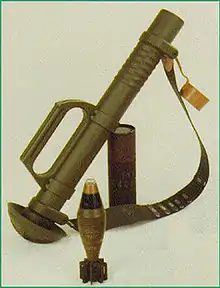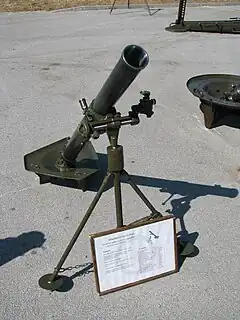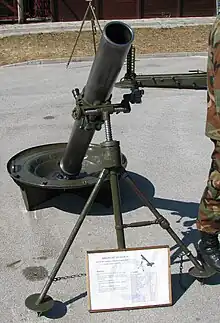Kosovo Security Force
The Kosovo Security Force (KSF; Albanian: Forca e Sigurisë së Kosovës; Serbian: Косовске безбедносне снаге/Kosovske bezbednosne snage) is the military of Kosovo. KSF is tasked with defending the sovereignty and territorial integrity of Kosovo, military support for civil authorities, and participation in international peacekeeping missions and operations.[1] Since 2018, it is in the process of transforming into the Kosovo Armed Forces, a process that is expected to finish in 2028.
| Kosovo Security Force | |
|---|---|
| Albanian: Forca e Sigurisë së Kosovës Serbian: Косовске безбедносне снаге | |
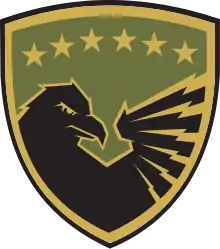 Emblem | |
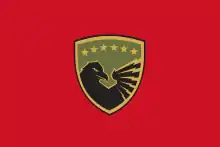 Flag | |
| Founded | 1 January 2009 |
| Current form | 14 December 2018[lower-alpha 1] |
| Headquarters | Pristina, Kosovo |
| Website | mod.rks-gov.net/ |
| Leadership | |
| Commander-in-chief | Vjosa Osmani |
| Minister of Defense | Ejup Maqedonci |
| Commander | Lt. Gen. Bashkim Jashari |
| Personnel | |
| Military age | 18 |
| Active personnel | 10,000 |
| Reserve personnel | 5,000 |
| Expenditures | |
| Budget | €141,000,000 (2023) |
| Percent of GDP | 1.30% (2023) |
| Industry | |
| Foreign suppliers | |
| Related articles | |
| History | Kosovo Liberation Army Kosovo Protection Corps |
| Ranks | Military ranks of Kosovo |
The President of Kosovo is the Supreme Commander of the Kosovo Security Force and has the competence for mobilizing the Kosovo Security Force in cases of the state of emergency.[2] In peace times, the President's powers as Commander-in-Chief are executed through the Prime Minister and the Defence Minister.
History

Following the Kosovo War in 1999, United Nations Security Council Resolution 1244 placed Kosovo under the authority of the United Nations Interim Administration Mission in Kosovo (UNMIK), with security provided by the NATO-led Kosovo Force (KFOR). KFOR entered Kosovo on June 12, 1999 under a United Nations mandate, two days after the adoption of UN Security Council Resolution 1244.
After KFOR's entry into Kosovo, the Kosovo Liberation Army was disbanded and some of its members joined the newly-formed Kosovo Protection Corps (KPC). According to UNMIK regulation 1999/8, the KPC's tasks were to provide disaster response, conduct search and rescue operations, provide humanitarian assistance, assist in demining, and contribute to rebuilding of infrastructure after the war. KPC's membership grew over time, but it never had any role in defense, law enforcement, riot control, internal security, or any other law and order tasks. In 2007, the United States army transferred Camp Monteith in Gjilan to the Kosovo Protection Corps.
Kosovo declared its independence from Serbia in February 2008. On 19 March 2008, United States President George W. Bush authorised military aid to Kosovo in another step to establish formal relations with Kosovo.[3] In March 2008, the NATO-led Kosovo Force (KFOR) and the KPC started preparations for the formation of the Kosovo Security Force. According to guidelines laid out in the Ahtisaari Plan, the Kosovo Security Force was initially permitted to carry light weapons. The admission and the training of personnel began in early June 2008, when NATO experts arrived in Kosovo to guide the process, and from early December 2008, enlisting of candidates between 18 and 30 years old began.
On 20 January 2009, the names of those who were to be selected for the KSF from the KPC were announced. After being vetted by NATO, roughly 1,400 former members of the KPC were selected to serve as officers and rank and file members of the KSF.
On 21 January 2009, the Kosovo Security Force was officially launched. The KSF did not replace the Kosovo Protection Corps (KPC) which was disbanded several months later. KFOR was charged with mentoring the KSF and bringing the force to Full Operational Capability. As part of this effort, various nations that are part of KFOR have provided assistance to the force on a bilateral basis including uniforms which were supplied by the United States and vehicles which were donated by Germany. Mentoring efforts were meant to develop the KSF in line with NATO standards.[4][5][6] Additionally Italy, Portugal and other NATO members are to help the KSF by donations and training.[7][8] Slovenia donated €30,000 towards the establishment of the KSF.[6]
The following senior officers took their oaths on 16 June 2009, under the supervision of then KSF Commander Lieutenant-General Sylejman Selimi:[9]
- Lieutenant-General Bashkim Jashari – KSF Deputy Commander and Commander of Land Force Command
- Brigadier-General Xhevahir Geci – Commander of Rapid Reaction Brigade
- Brigadier-General Zymer Halimi – Chief of Operations and Training Department
- Brigadier-General Imri Ilazi – Commander of Operations Support Brigade
- Brigadier-General Enver Cikaqi – Commander of Training and Doctrine Command
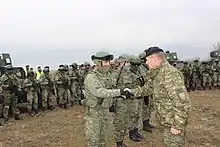
On 15 September 2009 the Kosovo Security Force officially began the work, with its initial operational capacities after an eight-month training with NATO instructors.[10]
In 2010, the KSF deployed to northern Albania on two separate occasions to perform flood relief operations in support of the Albanian domestic response.
On 22 November 2011, Lieutenant General Sylejman Selimi retired from the KSF and President Atifete Jahjaga appointed the former Director of Operations Major General Kadri Kastrati to succeed him as Commander of the force. President Jahjaga also promoted Kastrati to the rank of lieutenant general.
On 9 July 2013, the North Atlantic Council determined that the Kosovo Security Forces had reached Full Operational Capability (FOC), with regards to non-military security operations that were not appropriate for the police. This included search and rescue operations, explosive ordnance disposal, control and clearance of hazardous materials, fire-fighting and other humanitarian assistance tasks..[11]
NATO's role in the creation of KSF has therefore been two-fold: helping with its formation – standing up, recruitment and training; and the establishment of a civilian-led organisation to supervise and control the KSF. One of the principal aims was to encourage all minorities to enroll, so special attention was given to carrying out the recruitment process in two languages – Albanian and Serbian. The result has been a professional, multi-ethnic, all-volunteer force, which should continue to remain a source of regional stability. Following the declaration of full operational capability, NATO will continue to support the development of the KSF through the NATO Liaison and Advisory Team (NLAT), consisting of a mix of approximately 30 military and civilian personnel that will help with the professional development of the KSF, providing advice and support in a variety of areas such as capacity-building and training and leadership.[12]
Towards a Kosovo Armed Forces
On 5 March 2014, Prime Minister Hashim Thaçi declared that the Kosovan government had decided to establish a Defence Ministry and by 2019, officially transform the Kosovo Security Forces into the Kosovo Armed Forces (Albanian: Forcat e Armatosura të Kosovës, FAK) which will meet all the standards of NATO states with the aim of joining the alliance in the future. The new army will have a €98 million annual budget and will be 5,000 strong with another 3,000 reservists, composed of land forces, a national guard, logistics and training commands.[13][14][15] Kosovo's Security Forces Minister Agim Çeku stated that the Kosovo Armed Forces' mission will be "to protect the sovereignty and territorial integrity of Kosovo, its people and their property and protect the interests of the Kosovo Republic".[16] Kosovo's ambassador to Turkey, Avni Spahiu, stated that the "decision to establish an army has been taken in consultation with NATO and our partners... [and] the army will have a defensive character as Kosovo has no territorial aspirations".[17]
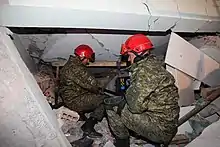
On 28 May 2014, President Atifete Jahjaga told the United Nations Security Council that the creation of the Kosovan Armed Forces would be a long process, requiring the support and participation of all ethnic communities in Kosovo; she added that its purpose would be to contribute to overall security in the Balkans and called on all ethnic communities to take part in the process.[18] In November 2014, Agim Çeku stated that the Kosovo Army was running behind schedule "because of the delay in the constitution of the Kosovo parliament" but the decision to transform the Kosovo Security Force into an Army will be confirmed "at one of the first sessions upon its constitution"; he also noted that this transformation enjoys nationwide support and he doesn't expect any complaints from the political opposition.[19]

On 18 October 2018, the Kosovo Assembly approved to transform the Kosovo Security Force into the Kosovo Armed Forces within 10 years after 98 of the 120 deputies voted in favor, and the remaining 22 remained absent from the vote, including 11 representatives from the Serb minority who boycotted the vote.[20]
With the aim to upgrade its military competencies and to make it able to join NATO, on 14 December 2018, the Assembly of Kosovo passed legislation to redefine the KSF as a "professional military force" and to establish a defence ministry.[21][22][23] The transformation is supposed to be finished in 2028. The Iowa National Guard is one of Kosovo Security Force's main partners and supporters in its transformation.[24]
The KSF's personnel trains in NATO military academies in Turkey, the US, and the UK, including School of Army Aviation in Isparta, West Point, and Sandhurst. Its current transformation is actively supported by NATO members and its closest cooperation is with the Iowa National Guard. After the beginning of the Russian invasion of Ukraine, the Assembly of Kosovo passed a resolution, urging the government to start NATO membership bid.[25]
Reactions

Reactions to the transformation of KSF to KAF have been mixed. The move has been seen with scepticism by Serbia and by NATO, European Union and United Nations officials, but it has been endorsed by the United States, as well as the governments of Germany, United Kingdom and France.[26][27]
The Serbian authorities have repeatedly said that according to all international documents, and especially UN Resolution 1244, NATO-led KFOR is the only legal military formation in Kosovo alongside 999 Serbian military personnel guaranteed by Resolution 1244.[28] Jens Stoltenberg, Secretary General of NATO, said he regrets that the Kosovo Assembly has decided to transform KSF despite concerns from the alliance, adding that "this move comes at the wrong time".[29] Also, Federica Mogherini, High Representative of the European Union for Foreign Affairs has expressed regret over Kosovo's move to form a new army.[30] Furthermore, António Guterres, UN Secretary-General, expressed deep concern over the decision of Kosovo authorities, urging "all parties concerned" to exercise restraint.[31]
On the other hand, the United States fully supports and endorses the move. In a statement, the US Embassy in Kosovo stated that Kosovo is a sovereign nation, and as such, it is allowed to have a force to defend its territory. They confirmed that the United States will continue to support the development of KAF, and that they expect the cooperation of the KAF and NATO to continue.[32] The US. Ambassador in Kosovo, Philip S. Kosnett called the transformation a historical move.
Mission statement
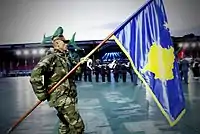
Kosovo Security Force's duties are to defend the sovereignty and territorial integrity of the Republic of Kosovo, provide military support to civilian authorities, and to participate in international military operations.
The Ministry of Defense of the Republic of Kosovo (MoD) is responsible for exercising civilian control over the Force, including management and administration. It comprises a mixture of civilian and KSF personnel and is accountable, through the Prime Minister, to the Kosovo Assembly.
The mission of the MoD, is to formulate, implement, evaluate and develop the policies and activities of the KSF within a framework of democratic governance and in accordance with the Constitution and laws of the Republic of Kosovo.
Personnel
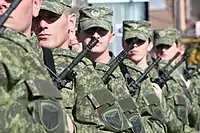
Any citizen of Kosovo over the age of 18 is eligible to serve in the Kosovo Security Force.[33] Active members of the Kosovo Security Force are not legally allowed to run for, or serve in the Assembly of Kosovo.[34] The membership of the Kosovo Security Force is required to reflect the ethnic composition of the country.[35] Members of the Security Force are protected from discrimination on the basis of gender or ethnicity.[36]
The Ministry of Defense has taken active steps to recruit women into the Security Force. As of 2015, women made up 8.52% of the uniformed service members of the Security Force and 32% of the Ministry as a whole.[37] Of the 203 women in uniform in the Security Force, 21 are officers; the highest ranking woman in the Security Force is a Major-general Irfete Spahiu.[38]
According to the Law on the Kosovo Security Force, KSF can have up to 5,000 active soldiers and up to 3,000 reservists, but it allows the Force to recruit above that number based on strategic defense reviews.[39] As of 2023, KSF has surpassed the 5,000 active members threshold and is steadily recruiting over 1,000 new members per year.
Ethnic minorities
Ethnic minorities of Kosovo are encouraged to enroll in the Kosovo Security Force with Kosovo's constitution requiring the integration of ethnic-minority communities into the Kosovo Security Force. In April 2013, 179 (8.2%) of the Kosovo Security Force's military personnel came from minority backgrounds, the remainder being ethnic Albanians.[40] In May 2014, Kosovar President Atifete Jahjaga noted to the United Nations Security Council that 9% of the KSF were from minority communities.[18] In July 2018 40 out of 137 Serbs tendered their resignations from the KSF. Minister of the KSF, Rustem Berisha stated that the personnel in question were pressured by Belgrade and had received "blackmail and threats" violating their basic human rights.[41]
| Ethnicity | Number |
|---|---|
| Turks | 49 |
| Serbs | 45 |
| Bosniaks | 43 |
| Ashkali | 30 |
| Egyptians | 14 |
| Croats | 3 |
| Romani | 3 |
| Gorani | 1 |
| Germans | 1 |
Structure
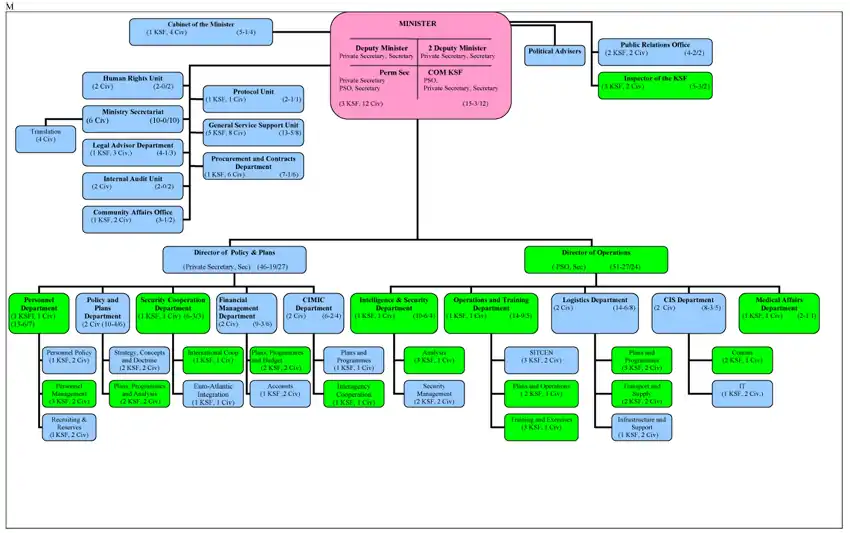
Under the headquarters staff depicted above, the KSF comprises the Land Force Command (Rapid Reaction Brigade of three battalions, First Battalion at Gjilan and Second Battalion at Istog;[43]) Operational Support Brigade, including engineer unit and Civil Protection Regiment; Doctrine and Training Command); plus a Logistics Command and National Guard Command (2023).[44] There are approximately 3,300 KSF personnel, including reserves.
Military rank insignias

- Officers
| Rank group | General / flag officers | Senior officers | Junior officers | Officer cadet | ||||||||||||||||||||||||||||||||
|---|---|---|---|---|---|---|---|---|---|---|---|---|---|---|---|---|---|---|---|---|---|---|---|---|---|---|---|---|---|---|---|---|---|---|---|---|
 |
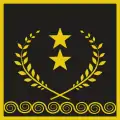 |
 |
 |
 |
 |
 |
 |
 |
||||||||||||||||||||||||||||
| Gjeneral lejtnant | Gjeneral major | Gjeneral brigade | Kolonel | Nën kolonel | Major | Kapiten | Toger | Nën toger | ||||||||||||||||||||||||||||
- Enlisted
| Rank group | Senior NCOs | Junior NCOs | Enlisted | |||||||||||||||||||||||||||||||||
|---|---|---|---|---|---|---|---|---|---|---|---|---|---|---|---|---|---|---|---|---|---|---|---|---|---|---|---|---|---|---|---|---|---|---|---|---|
 |
 |
 |
 |
 |
 |
|||||||||||||||||||||||||||||||
| Rreshter major | Rreshter i parë | Kapter | Rreshter | Tetar | Ushtar | |||||||||||||||||||||||||||||||
Equipment
Weapons
Vehicles
| Picture | Name | Country manufactured | Number | Notes | Reference |
|---|---|---|---|---|---|
| Light utility vehicles | |||||
.jpg.webp) |
Mercedes-Benz G Class | N/A | |||
 |
Land Rover Defender | N/A | |||
 |
Jeep | N/A | |||
 |
Otokar Akrep | 3 | [52] | ||
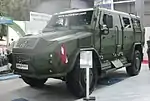 |
Achleitner | N/A | |||
| Light armored vehicles and MRAPs | |||||
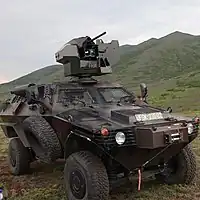 |
Otokar Cobra | 80 | [53][54][49] | ||
 |
Humvee | 200+ | [55][56][57] | ||
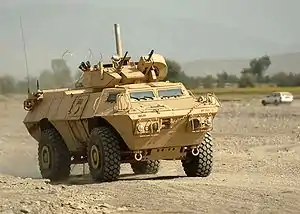 |
M1117 Guardian | 55 | [58] | ||
 |
BMC Kirpi | 10 | [52] | ||
 |
BMC Vuran | 26 | 12 of them equipped with the Roketsan TR-107 MLRS system. 14 equipped with Aselsan Alkar 120mm mortars. | [52] | |
| Trucks | |||||
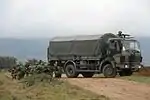 |
Mercedes-Benz NG 1017A | N/A | |||
 |
Mercedes-Benz Unimog | N/A | |||
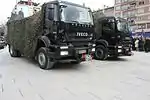 |
Iveco Trakker | N/A | |||
 |
Iveco 8X8 | N/A | |||
 |
FMTV | N/A | |||
 |
MB Man | 15 | KSF purchased 12 trucks in 2018; an additional 3 were donated by the German Embassy in 2023. | ||
 |
UAV ground control station | 2 | |||
Kosovo Airforce
| Name | Picture | Origin | Numbers | Notes | Reference |
|---|---|---|---|---|---|
| Unmanned combat aerial vehicles (UCAVs) | |||||
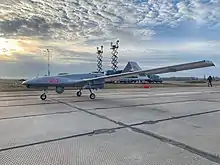 |
Baykar Bayraktar TB2 | 5 | Received in 2023. Equipped with Roketsan MAM-C and MAM-L precision-guided munition. | [49] | |
| Unmanned aerial vehicles | |||||
 |
AeroVironment RQ-20 Puma | 40 | First batch of 40 received in 2022. | [59] | |
 |
AAI RQ-7 Shadow | N/A | |||
 |
STM Alpagu | 100 | 50x Thermobaric & 50x Armour-piercing warheads. | ||
| Airports | ||||
|---|---|---|---|---|
.jpg.webp) |
Pristina International Airport "Adem Jashari" | Pristina (Sllatina) | Civil and Military use | This airport contains NATO standards for military (airforce) uses. |
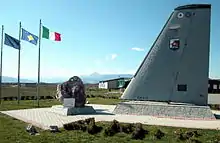 |
Gjakova Military Airport | Gjakova | Military use | The airport is owned by the Kosovo Ministry of Defense, and it is being used for the needs of KSF since 2018. |
| Dumosh-Batllava Airfield | Podujevo | Military Use | This Airfield is officially managed by KSF, but is out of order. | |
| Air Bases | ||||
| Sllatina Airbase | Pristina (Sllatina) | Only Military use | The activities in this air base are not very public, but it is known that recently this airbase has been strengthened and keeps the air assets inside. | |
Kosovo Military Camouflage
| 1st Kosovo Camo | ||||
|---|---|---|---|---|
| Picture | Usage example | Name | Use | Description |
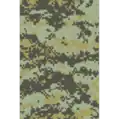 |
Kosovo Green Digital Camo | Uniform | This camouflage was established immediately after disbursement of Kosovo Protection Corps (TMK), KSF worked continuously with this Camo. | |
| Backpack | ||||
| Tents etc. | ||||
| 2nd Kosovo Camo | ||||
|---|---|---|---|---|
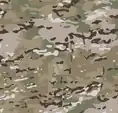 |
Kosovo wooden Digital Camo | Uniform | This camo was established in October 2022, by the supreme commander of the force Vjosa Osmani. | |
| 3rd Kosovo Camo | ||||
|---|---|---|---|---|
 |
Matt Green Camo | Vehicles | This camo is used to mark the land vehicles of KSF. | |
| Aerial Vehicles Camo | ||||
|---|---|---|---|---|
 |
Aerial Grey Camo | Drones and UAV-s | ||
Kosovo Army Medals and Decorations
| Medal of Appreciation | |
|---|---|
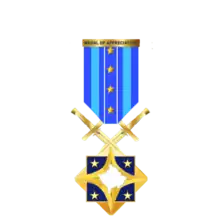 |
This medal is given to special people from KSF or KMD for their contributions in Kosova. The current,past ministers of defense, turkish KFOR commander etc, were decorated with |
Notes
- In the process of moving from Kosovo Security Force to Kosovo Armed Forces.
References
- "LAW NO. 06 L-123 ON KOSOVO SECURITY FORCE". Article IV, Law of 4 January 2019. Assembly of the Republic of Kosovo.
- "LAW NO. 06 L-123 ON KOSOVO SECURITY FORCE". Article XVI, Law of 4 January 2019. Assembly of the Republic of Kosovo.
- Bush OKs supplying arms to Kosovo, AFP, March 19, 2008.
- "Lt. Gen. Selimi appointed as Chief of Staff of KSF" Archived 2009-03-07 at the Wayback Machine newkosovoareport.com 20 December 2009. Link accessed 21-01-09
- "Kosovo's security force launched" news.bbc.co.uk 21 January 2009. Link Retrieved 21-01-09
- "Kosovo: Security or militarisation?" Archived 26 December 2018 at the Wayback Machine b92.net 21 January 2009. Link retrieved 21-01-09
- "Italy to support the establishment of Kosovo armed forces" Archived 2012-04-01 at the Wayback Machine newkosovoareport.com 24 December 2008. Link accessed 21-01-09
- "Portugal to assist the establishment of Kosovo Army" Archived 2009-06-04 at the Wayback Machine newkosovoareport.com 20 December 2008. Link accessed 21-01-09
- Ministry Press Release, 16 June 2009, Pristina
- "FSK nis zyrtarisht punën" (in Albanian). Pristina, Kosovo: Gazeta Express. 18 September 2009. Archived from the original on 2 May 2014. Retrieved 18 September 2009.
- "NATO Secretary General statement on Kosovo Security Force reaching Full Operational Capability".
- "The Kosovo Security Force now self-sustainable".
- "Kosovo to create national army of 5,000 soldiers". Reuters. 4 March 2014. Retrieved 9 March 2014.
- "Kosovo to Have Army by 2019". noinvite.com. 5 March 2014. Retrieved 9 March 2014.
- "Kosovo to build its first national army". Euronews. 4 March 2014. Archived from the original on 9 August 2015. Retrieved 11 March 2014.
- "Kosovo to Have Armed Forces by 2019". Balkan Insight. 4 March 2014. Retrieved 16 September 2014.
- "Kosovo to form army 15 yrs after war, Serbia reacts". Turkish Weekly. 11 March 2014. Archived from the original on 13 March 2014. Retrieved 11 March 2014.
- "Kosovo precedent created new hotspots". B92. 28 May 2014. Retrieved 28 May 2014.
- "Kosovo will soon have its army". B92. 26 November 2014. Retrieved 26 November 2014.
- Bozinovski, Igor (25 October 2018). "Kosovo Security Forces to be transformed into army". IHS Jane's 360. Skopje. Archived from the original on 25 October 2018. Retrieved 29 October 2018.
- "Kosovo approves new army despite Serbia opposition - News - Al Jazeera". www.aljazeera.com. Retrieved 14 December 2018.
- "Kosovo approves new army despite Serb opposition, NATO criticism". Reuters. 14 December 2018. Retrieved 14 December 2018.
- https://kallxo.com/wp-content/uploads/2018/09/2824-2.pdf
- "Iowa National Guard strengthens bonds with Kosovo". National Guard. National Guard. 5 October 2016. Retrieved 20 February 2022.
- "Kosovo parliament urges government to start NATO membership bid". Reuters. 3 March 2022. Retrieved 9 March 2022.
- "Kosovo legislature approves creation of national army". www.dw.com. 14 December 2018. Retrieved 15 December 2018.
- "Franca përkrahë transformimin e FSK-së në Ushtri të Kosovës". www.telegrafi.com. 14 December 2018. Retrieved 15 December 2018.
- "Kosovo army has no business in North, Serbs say". B92. 14 December 2018. Retrieved 14 December 2018.
- "Kosovo Parliament Votes to Create an Army, Defying Serbia and NATO". The New York Times. 14 December 2018. Retrieved 14 December 2018.
- "The Latest: Serbia calls new Kosovo army illegal". abcnews.go.com. 14 December 2018. Retrieved 14 December 2018.
- "UN Security Council discusses Kosovo, Guterres calls for restraint". N1. 15 December 2018. Retrieved 16 December 2018.
- "Statement from U.S. Embassy Pristina". 14 December 2018. Retrieved 15 December 2018 – via xk.usembassy.gov.
- "The Law on the Kosovo Security Force". Article Article 13, Section 13.1, Act No. Law No. 03/L-046 of 13 March 2008 (PDF). Archived from the original (PDF) on 3 March 2016. Retrieved 7 July 2016.
- "Article 73, Section 1(2)" (PDF). Constitution of Kosovo. 9 April 2008. Retrieved 7 July 2016.
- "Article 126, Section 4" (PDF). Constitution of Kosovo. 9 April 2008. Retrieved 7 July 2016.
- "Law on Service in the Kosovo Security Force". Article Article 3, Section 3(a), Act No. Law No. 03/L-082 of 13 June 2008 (PDF). Archived from the original (PDF) on 4 May 2016. Retrieved 7 July 2016.
- Annual Report 2015 (PDF) (Report). Ministry for the Kosovo Security Force. December 2015. p. 20. Archived from the original (PDF) on 26 March 2017. Retrieved 7 July 2016.
- THE WOMAN SHAPING KOSOVO'S FUTURE SOLDIERS (Report). Kosovo 2.0. March 2018. Retrieved 1 December 2021.
- "Ligji për FSK". Gazeta Zyrtare e Republikës së Kosovës.
- "Ministry for the Kosovo Security Force Newsletter" (PDF) (Press release). Ministry for the Kosovo Security Force. April 2013. Archived from the original (PDF) on 8 April 2016. Retrieved 7 July 2016.
- "Ministar KBS: Više od 40 od 137 srpskih pripadnika KBS traži da istupi". kossev.info. 7 July 2018. Retrieved 23 April 2019.
- Rushiti, Natyra (8 March 2017). "FSK-ja me 45 serbë, javën tjetër bëhet ushtri". Zëri. Retrieved 14 December 2018.
- "Forcing the security issue". Kosovo 2.0. 23 December 2017. Retrieved 31 May 2023.
- "Kosovo". 30 May 2023.
- "Emblems and Ranks". mod.rks-gov.net. Ministry of Defence. Retrieved 30 May 2021.
- "FSK Blen Armët e Para" [FSK Money Buys Weapons]. Gazeta Express (in Albanian). Kosovo: MediaWorks. 10 February 2010. Archived from the original on 13 February 2010.
- "Contract Awards Notice 21700/16/030/115" (PDF). Ministry for the Kosovo Security Force. 9 June 2016. Archived from the original (PDF) on 16 August 2016. Retrieved 26 July 2016.
- "MKE'den Kosova'ya PMT-76-57A ihracatı | SavunmaSanayiST" (in Turkish). 21 May 2023. Retrieved 3 June 2023.
- Mitzer, Stijn; Oliemans, Joost (7 August 2023). "Lock and 'Lokum': Turkish Weapons Bolstering Kosovo's Security Forces". Oryx. Retrieved 8 August 2023.
- Vatovci, Isa (28 May 2021). "Veçoritë e snajperit modern të Forcës së Sigurisë (FOTO)" [Features of the most modern sniper of the Security Force (PHOTO)]. Kallxo (in Albanian). Pristina. Retrieved 10 August 2023.
- "Roketsan'dan Kosova'ya OMTAS Füzesi ihracatı" (in Turkish). 21 May 2023. Retrieved 3 June 2023.
- Top News - FSK-ja blen 14 autoblinda turke/ Kosova, shteti i parë i huaj që merr këto mjete 4x4, archived from the original on 15 December 2021, retrieved 13 July 2021
- "Turqia: Kosova duhet të ketë ushtri". Archived from the original on 24 September 2015. Retrieved 2 August 2015.
- "43 members of the First Battalion of RRB completed two–months training with armored vehicle "KOBRA"" (Press release). Ministry for the Kosovo Security Force. 24 June 2016. Retrieved 7 July 2016.
- Crosby, Alan; Cubolli, Krenare (14 December 2018). "Humvees Shine Headlights On Kosovo's Controversial Vote On Army". Radio Free Europe/Radio Liberty. Retrieved 28 April 2022.
- "Kosovo Receives 55 Armored Vehicles Donated By U.S." Radio Free Europe/Radio Liberty. 30 August 2021. Retrieved 28 April 2022.
- Njekomb.com (2 September 2021). "Sa mjete ushtarake të tipit Humvee ka Ushtria e Kosovës?". Njekomb.org. Retrieved 28 April 2022.
- Ministry of Defence of the Republic of Kosovo. "Log into Facebook". Facebook. Retrieved 6 June 2021.
{{cite web}}: Cite uses generic title (help) - "Kosovo awaits Puma LE". Shephard. 25 January 2022. Retrieved 25 September 2023.
.jpg.webp)
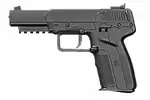









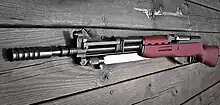



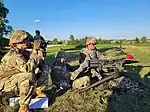




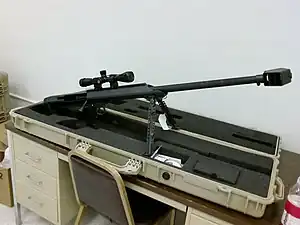
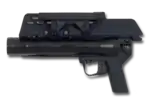



.JPG.webp)

